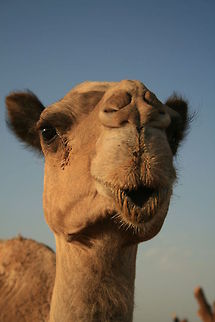
Appearance
The dromedary is the largest camelid, next to the Bactrian camel. Adult male dromedaries grow to a height of 1.8–2 m and females to 1.7–1.9 m. Their weight is usually in the range of 400–600 kg for males and 300–540 kg for females. The dromedary broadly overlaps in size with the Bactrian, though is perhaps slightly smaller on average, as male Bactrian camels regularly exceed 600 kg. Very large male dromedaries, however, can weigh as much as 1,000 kg.Their coats can range from dark brown to a much lighter sandy beige colour, and hair is concentrated more on the neck, hump, and shoulder. The male dromedary has a soft palate, called "dulaa" in Arabic, which it inflates to produce a deep pink sac. This palate is often mistaken for the tongue, as it hangs out of the side of the male's mouth to attract females during the mating season. Dromedaries are also noted for their thick eyelashes and bushy eyebrows. The hump, which can be 20 cm tall or more, is made up of fat bound together by fibrous tissue. The dromedary has long and powerful legs with two toes on each foot, which resemble flat, leathery pads. Unlike many other animals, camels move both legs on one side of the body at the same time, giraffes also move like this, which results in a swaying motion. They can adapt their body temperature from 34°C to 41.7°C, to conserve water. The dromedary camel exhibits sexual dimorphism, as both sexes are quite different in their appearance. They have sharp eyesight and a good sense of smell. The cranium has a well-composed sagittal crest, long facial part, and an indented nasal bone. They have an average lifespan of 40 years, which can be extended to 50 years in captivity.The dromedary has 22 milk teeth, which are eventually replaced by 34 permanent teeth. The lenses of their eyes contain crystallin, which constitutes 8-13% of the total protein present there. The epidermis is 0.038–0.064 mm thick, and the dermis is 2.2–4.7 mm thick. Though glands are absent on the face, males have glands 5–6 cm below the neck crest, on either side of the midline of the neck. These seem to be modified apocrine sweat glands which secrete a smelly, coffee-coloured fluid during rut. The females have mammary glands, four-chambered and cone-shaped, which are 2.4 cm in length and 1.5 cm in diameter at the base. They can continue to lactate even during dehydration, with the water content exceeding 90%.
The heart is 5 kg in weight, and has two ventricles with the apex curving to the left. Its pulse rate is 50 beats per minute. The normal blood volume is 0.093 l. The lungs are not lobed, and a dehydrated camel has a lower breathing rate. The kidneys each have a volume of 858 cm3, and can produce urine with high chloride concentrations. It is the only mammal with oval red blood corpuscles, and it lacks a gall bladder. The liver is divided into four parts and is triangular; the dimensions are 60×42×18 cm and has a mass of 6.5 kg. The spinal cord averages 213.6 cm in length, ending at the second and third sacral vertebrae.
The ovaries, present in females, are reddish in colour, circular, and flattened. They are enclosed in a conical bursa, and have a size of 4×2.5×0.5 cm during anestrus. The oviducts are 25–28 cm in length. The uterus is bicornuate. The vagina is 3–3.5 cm in length. The vulva is 3–5 cm deep and contains a small clitoris. The placenta is diffuse and epitheliochorial with a crescent-like chorion. The scrotum, present in males, is located high in the perineum with testicles in separate sacs. Testicles are 7–10 cm long, 4.5 cm deep and 5 cm in width. The right testicle is often smaller than the left. During the rut, the mass of both testicles ranges from 165–253 g, otherwise it is less than 140 g. The prostate gland is dark yellow, usually disc-shaped and divided into two lobes. The Cowper's gland is white, shaped like an almond, and lacks seminal vesicles. The penis is covered by a triangular penile sheath opening backwards, and is about 60 cm long.
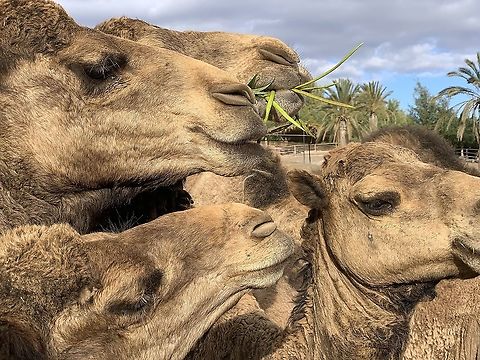
Distribution
The dromedary occupies arid regions, notably the Sahara Desert in Africa. The original range of the camel’s wild ancestors was probably south Asia and the Arabian peninsula. They inhabit the dry, hot regions of North Africa, Ethiopia, the Near East, and western to central Asia. All African camels are dromedaries, of which 84% occur in Somalia, Ethiopia, Sudan, Djibouti and Kenya, which constitutes 60.1% of the world's whole camel population. In the Horn of Africa, the dromedary can occur as far south as 2°S, where the annual rainfall may be 550 mm. The dromedary overlaps in distribution with the Bactrian camel in Afghanistan, Pakistan, and southwest Asia. Richard Bulliet has observed that dromedaries exist where the Bactrian camel do not, and Bactrian camels exist where dromedaries do not. He concluded this can be because the nomads of Syrian and Arabian deserts valued the dromedary more, whereas Asiatic people preferred the Bactrian camel.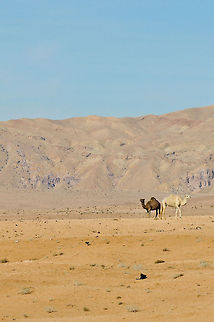
Behavior
Some special behavioral features of the camel include snapping at other camels without biting them, showing displeasure by stamping feet, running, and occasionally vomiting cud when hurt or excited. They prefer walking in a single file. Camels find comfort in scratching parts of their bodies with their front or hind legs or with their lower incisors. They are also seen rubbing against tree bark and rolling in the sand. Their main vocalizations include a sheep-like bleat used to locate individuals and the breeding gurgle of males, while a whistling noise is produced as a threat noise by males by grinding the teeth together. They are not usually aggressive, with the exception of rutting males. The males of the herd prevent their females from interacting with other bachelor males by standing or walking between them and driving other males away. Camels seem to remember their homes; females in particular remember the place they first gave birth or suckled their offspring. They do not defecate in any special posture, and marking behavior is common.A 1980 study found androgen levels in the blood of males influenced their behavior. Between January and April, when these levels are high due to their being in rut, they become difficult to manage, blow out a palate flap from the mouth, vocalize, and throw urine over their backs with their tails.
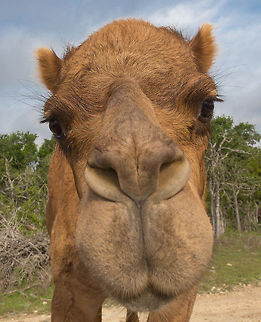
Reproduction
Females reach sexual maturity around three years of age and mate around age four or five. Males begin to mate at around three years of age, too, but still are not sexually mature until six years of age. Mating occurs in winters, but peaks in the rainy season. The onset of the breeding season is believed to be cued by nutritional status of the camel and the daylength.If mating does not occur, the follicle, which grows during estrus, usually regresses within a few days. In one study, 35 complete estrous cycles were observed in five nonpregnant females over a period of 15 months. The cycles were about 28 days long, in which follicles matured in six days, maintained their size for 13 days, and returned to their original size in eight days. In another study, ovulation could be best induced when the follicle reaches a size of 0.9–1.9 cm. In another study, pregnancy in females could be recognized as early as 40 to 45 days of gestation by the swelling of the left uterine horn, where 99.52% of pregnancies were located.
During the reproductive season, males splash their urine on their tails and nearer regions. Males also extrude their soft palate. Copious saliva turns to foam as the male gurgles, covering the mouth. Males threaten each other for dominance over the female by trying to stand taller than the other, making low noises and a series of head movements including lowering, lifting, and bending their necks backwards. A male tries to defeat other males by biting at his legs and taking the opponent's head in between his jaws. Copulation begins with a necking exercise. The male smells the female's genitals, and often bites her in this region or around her hump. The male makes the female sit, and then grasps her with his forelegs. Normally, three to four ejaculations occur. The camelmen often aid the male to enter his penis into the female's vulva, though the male is considered able to do it on his own. Copulation time ranges from 7–35 minutes, averaging 11–15 minutes.
A single calf is born after a gestational period of 15 months. Calves move freely by the end of their first day. Nursing and maternal care continue for one to two years. In a study to find whether young could exist on milk substitutes, two male young camels, one month old, were separated from their mothers and were fed on milk substitutes prepared commercially for lambs. For the initial 30 days, the changes in their weights were marked. Each gained 0.400 kg and 1 kg, respectively, per day. Finally, they were found to have grown properly and weighed normal weights of 135 kg and 145 kg.
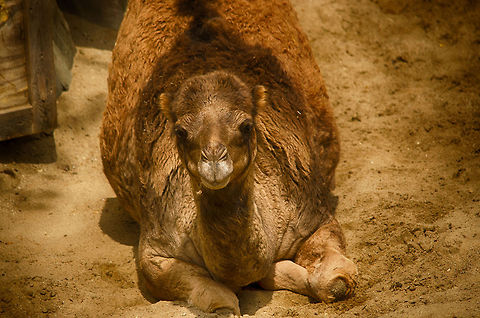
Food
The diet of the camel mostly consists of foliage, dry grasses, and available desert vegetation, mostly thorny plants growing in the camel's natural habitat. These comprise 70% of their diet in summer and 90% in winter. In the Sahara, 332 plant species have been recorded for the dromedary. The dromedary will feed on "Acacia", "Artiplex", and "Salsola" plants whenever available.They keep their mouths open while chewing thorny food. They use their lips to grasp the food, then chew each bite 40-50 times. Features like long eyelashes, eyebrows, lockable nostrils, caudal opening of the prepuce and a relatively small vulva help the camel avoid injuries, especially while feeding.
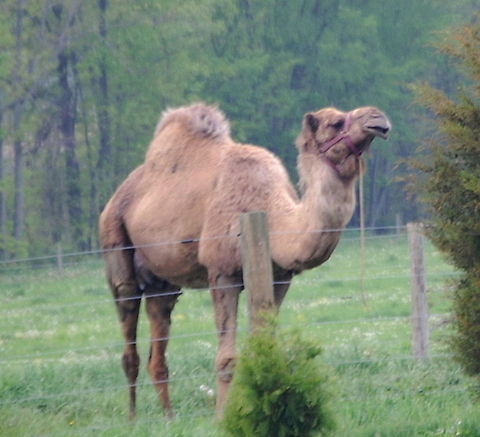
Uses
Dromedaries are used as beasts of burden in most of their domesticated range. Unlike horses, they kneel for the loading of passengers and cargo. A camel can carry an estimated 159–295 kg for 24 km for a long time. Camels can be trained to bear loads from five years of age, but must not be given a large load until six years old. Camels are usually patient animals, easier to train and tougher than cattle. Camels can also be used to pull carts, plows, and draw wheels. A dromedary can plow at a speed of 2.5 km per hour, but must not be worked for more than six hours a day. Their hair is durable and light, so it is used as a source material for woven goods, ranging from Bedouin tents to garments. The hair is clipped off using hand shears, or sometimes simply pulled, after which the camel's body is oiled. Juveniles less than two years of age have a fine undercoat, which is also used for these purposes. They also give wool. The wool produce of a herd of 4300 dromedaries in Russia in 1970 and 1974 was 557 kg and 576 kg, respectively.References:
Some text fragments are auto parsed from Wikipedia.